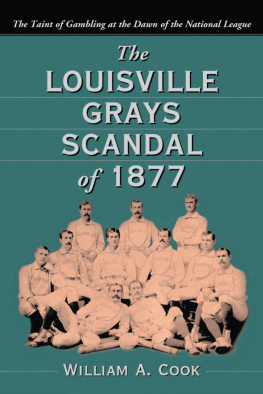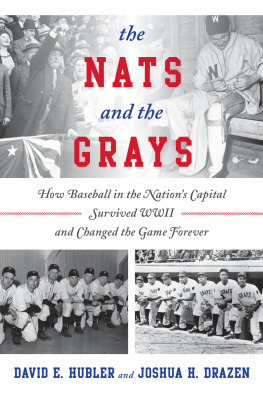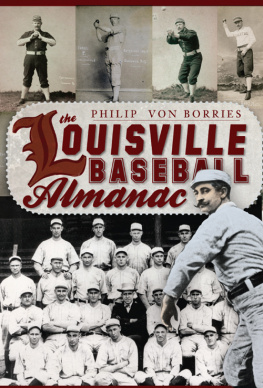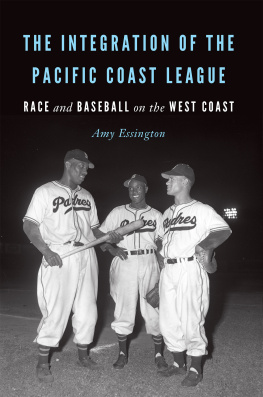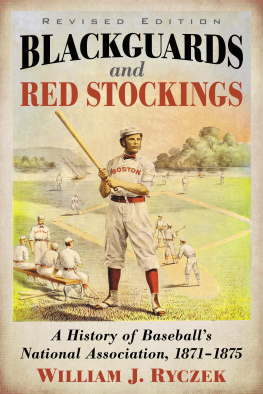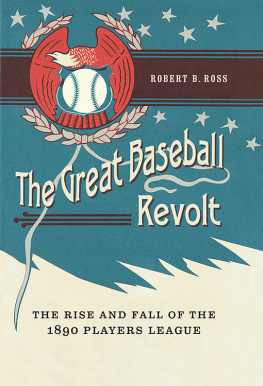
Also by William A. Cook
and from McFarland
Big Klu: The Baseball Life of Ted Kluszewski (2012)
Jim Thorpe: A Biography (2011)
August Garry Herrmann: A Baseball Biography (2008)
King of the Bootleggers: A Biography of George Remus (2008)
Pete Rose: Baseballs All-Time Hit King (2004)
Waite Hoyt: A Biography of the Yankees Schoolboy Wonder (2004)
The Summer of 64: A Pennant Lost (2002)
The 1919 World Series: What Really Happened? (2001)
The Louisville Grays Scandal of 1877
The Taint of Gambling at the Dawn of the National League
WILLIAM A. COOK

McFarland & Company, Inc., Publishers
Jefferson, North Carolina
LIBRARY OF CONGRESS CATALOGUING DATA ARE AVAILABLE
BRITISH LIBRARY CATALOGUING DATA ARE AVAILABLE
e-ISBN: 978-1-4766-1639-1
2005 William A. Cook. All rights reserved
No part of this book may be reproduced or transmitted in any form or by any means, electronic or mechanical, including photocopying or recording, or by any information storage and retrieval system, without permission in writing from the publisher.
On the cover: The 1876 Louisville Grays (Special Collections, Photographic Archives, University of Louisville)
McFarland & Company, Inc., Publishers
Box 611, Jefferson, North Carolina 28640
www.mcfarlandpub.com
For my great-niece
Annie Pardini,
an extraordinary lady
Preface
When I set out to write this book, I was surprised to discover that I was really quite naive about the evolution of professional baseball. For some reason I had been under the simplistic impression that the professional game was roughly divided into two eras, the modernfrom the beginning of the deadball years up to the presentand everything that came before. In at least one sense, I wasnt far off target; writing about nineteenth century professional baseball history is far different from writing about early twentieth century baseball or the game as we know it today. But the nineteenth century was a fascinating, uncertain time in the history of the game, and major changes in the rules, the leagues, and the styles of play (the 1800s their own brief batter- and pitcher-dominated years) created eras more distinct than any in the century that followed. And certainly the gambling, the roster raiding, and the contract jumping threatened the professional game far moreand more oftenthan Id guessed.
The players of the 1870s were somewhat obscure to me. While names and accomplishments of such early players as Cap Anson and Albert Spalding were familiar, scores of other early professionals who played major roles in shaping the game of the 1870s and beyond (such as Candy Cummings, George Hall, Bob Ferguson, Jim Devlin, Tommy Bond, Ross Barnes and many others), were almost foreign to me. Both the rules and structure of the game played in the 1870s were evolving and vastly different from todays game. So I had some homework to do in order to prepare an accurate picture of the early days of the National League and of its first major scandal.
First, I had to learn play the game of baseball by the rules of the 1870s. Thanks to various books, microfilm of ancient copies of The New York Clipper, and even the Internet, I accomplished that task. The next step in my preparation was to find out what had actually happened in those early days of the game and who were the persons involved. It was very fortunate for me indeed that there are numerous resources and archives with helpful persons to provide the information and direction required to get the facts, sort them out and reconstruct the necessary events in order to tell the story. I acknowledge them here.
Among the many great sources of information that I accessed in my research for the book was the most helpful and extremely knowledgeable staff at the Research Library of the National Baseball Hall of Fame and Museum in Cooperstown, New York. In addition to the numerous enlightening articles contained in the Halls research library, footnotes obtained from various articles in its files also provided a road map for obtaining secondary sources and to cross-reference various events. It should also be noted that the Halls photo archive services are superior in both material and service.
Another extremely important institution that provided information for this work was The New York City Public Library. Two sources of valuable information were accessed from the library. The first is the librarys microfilm collection of The New YorkClipper that is archived in the NYPL for the Performing Arts located at 40 Lincoln Center Plaza at 65th Street. The Clipper provides perhaps the most comprehensive accounts of box scores, dialogue on issues and rules changes of the 19th century game available from any other source. Also invaluable to my efforts was the access provided to the endless stream of information contained in The Albert Goodwill Spalding Collection, archived in the Manuscript And Archives Division of the NYPL Humanities and Social Science Library located at Fifth Avenue and 42nd Street. The staff also provided me with gracious assistance in locating a rare photo from its Spalding collection.
Also most supportive to my efforts was the Filson Historical Society of Louisville, Kentucky, which provided a unique contribution to this work from information contained in its Haldeman family collection. While the primary focus of the Filson collection is perpetuation of Kentucky frontier history, their staff assisted me with baseball research with both sincerity and dedication.
Still further, a very significant amount of invaluable information was found during my visit to the Hartford Public Library. The librarys extensive microfilm collection of The Hartford Daily Times was nearly equal in quantity and quality of information to that contained in The New York Clipper. In addition, three other public libraries should be noted for their gracious cooperation and valuable contributions to this work. The Boston Public Library was an invaluable resource with its microfilm collection of The BostonDailyGlobe. Likewise, The Public Library of Cincinnati and Hamilton County provided information from three local nineteenth century newspapers with accounts of games and issues in substantial detail, The Cincinnati Commercial, The Cincinnati Enquirer and TheCincinnati Daily Gazette. The Louisville Free Public Library also provided additional information from its collection of The Louisville Courier-Journal that provided a detailed hometown account of the scandal. My gratitude should also be extended to the Chicago Public Library, the Cleveland Public Library (Cleveland Research Center), the Indianapolis-Marion County Public Library, The Carnegie Free Public Library of New Brunswick, New Jersey and The Free Public Library of Philadelphia, for their minor, but no less important contributions to this work in providing necessary dedicated information on specific events from their collections.
Lastly, I should like to acknowledge the help that I received from PhotoFile of Yonkers, New York, in permitting me to search their photo archives and also the staff at the Chicago Historical Society and the Photographic Archives, Ekstrom Library, University of Louisville, for their help in obtaining a couple of unique photos for this work. And, a very special thanks to my friend Denise Habrack, who was so thoughtful and supportive to me during research field trips to Hartford, Connecticut, Hoboken, New Jersey and New York City.
Next page
